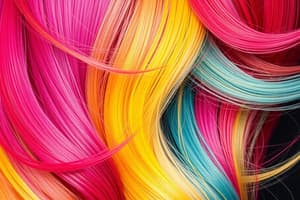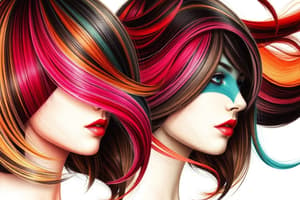Podcast
Questions and Answers
What happens when hair is overlightened?
What happens when hair is overlightened?
- It becomes unmanageable.
- It remains the same color as the base.
- It absorbs the base color of the toner. (correct)
- It turns entirely white.
When would a client want to use a dye remover?
When would a client want to use a dye remover?
- To change to a lighter shade. (correct)
- To correct excessive hair dryness.
- To maintain their current hair color.
- To add more color to their hair.
What is the primary function of oil-base dye removers?
What is the primary function of oil-base dye removers?
- To lift trapped color pigments without structural changes. (correct)
- To lighten the natural melanin in hair.
- To create drastic changes in hair color.
- To evenly deposit new hair color.
What type of filler is designed to correct porosity without affecting color?
What type of filler is designed to correct porosity without affecting color?
What is a characteristic of tint or dye solvents?
What is a characteristic of tint or dye solvents?
Which product type is recommended to help even out porosity in hair?
Which product type is recommended to help even out porosity in hair?
Which statement is true regarding filler products?
Which statement is true regarding filler products?
What is a characteristic of conditioner fillers?
What is a characteristic of conditioner fillers?
What is a result of overlightened hair when using toner?
What is a result of overlightened hair when using toner?
Which of the following conditions may require the use of dye removers?
Which of the following conditions may require the use of dye removers?
What characteristic is true for oil-base dye removers?
What characteristic is true for oil-base dye removers?
How do color fillers function in hair treatment?
How do color fillers function in hair treatment?
When should a clear filler be used?
When should a clear filler be used?
What is one property of tint or dye solvents?
What is one property of tint or dye solvents?
Which type of filler is available in protein and nonprotein forms?
Which type of filler is available in protein and nonprotein forms?
What is the purpose of toning in hair treatment?
What is the purpose of toning in hair treatment?
What happens to underlightened hair when toner is applied?
What happens to underlightened hair when toner is applied?
What is the purpose of oil-base dye removers?
What is the purpose of oil-base dye removers?
Which of the following statements about tint or dye solvents is true?
Which of the following statements about tint or dye solvents is true?
What type of product is a color filler designed to achieve?
What type of product is a color filler designed to achieve?
When should a client consider using dye removers?
When should a client consider using dye removers?
What is a characteristic of conditioner fillers?
What is a characteristic of conditioner fillers?
Which benefit does a clear filler provide?
Which benefit does a clear filler provide?
What is the preferred method regarding product lines in hair treatments?
What is the preferred method regarding product lines in hair treatments?
Flashcards are hidden until you start studying
Study Notes
Overlightened Hair
- Overlightened hair absorbs toner base color; underlightened hair shows more red, yellow, or orange hues than desired.
- Toning processes use semipermanent, demipermanent, or permanent hair colors as toners to achieve target results.
- Adhere to manufacturer instructions for selecting, mixing, and applying toners as formulations differ between brands.
- Using products from the same product line is advised for consistent results.
Tint or Dye Removers
- Artificial hair color removal may be necessary when clients wish to lighten their shade, correct coloring mistakes, or address overprocessing in porous hair.
Dye Removers
- Known as color or tint removers, two types are available for removing artificial pigments:
- Oil-base dye removers: They lift trapped color pigments and buildup from cuticle layers without altering hair structure or color levels significantly.
- Tint or dye solvents: These offer strong lightening effects on melanin, diffuse artificial pigments in the cortex, and are nonallergenic. No predisposition tests are needed as they lack aniline derivatives; follow directions closely due to their potency.
Fillers
- Fillers correct excessive porosity and establish a color base by penetrating the cuticle to fill in cortex gaps, ensuring even color application or lightening.
- Two categories of fillers exist:
- Conditioner fillers: Available in protein and nonprotein options, offered in gel, cream, or liquid forms.
- Color fillers: Dual-purpose products that provide color base and even out porosity in one step, available in clear, neutral, and various colors.
- Clear fillers correct porosity without altering color, and do not deposit a color base.
Overlightened Hair
- Overlightened hair absorbs toner base color; underlightened hair shows more red, yellow, or orange hues than desired.
- Toning processes use semipermanent, demipermanent, or permanent hair colors as toners to achieve target results.
- Adhere to manufacturer instructions for selecting, mixing, and applying toners as formulations differ between brands.
- Using products from the same product line is advised for consistent results.
Tint or Dye Removers
- Artificial hair color removal may be necessary when clients wish to lighten their shade, correct coloring mistakes, or address overprocessing in porous hair.
Dye Removers
- Known as color or tint removers, two types are available for removing artificial pigments:
- Oil-base dye removers: They lift trapped color pigments and buildup from cuticle layers without altering hair structure or color levels significantly.
- Tint or dye solvents: These offer strong lightening effects on melanin, diffuse artificial pigments in the cortex, and are nonallergenic. No predisposition tests are needed as they lack aniline derivatives; follow directions closely due to their potency.
Fillers
- Fillers correct excessive porosity and establish a color base by penetrating the cuticle to fill in cortex gaps, ensuring even color application or lightening.
- Two categories of fillers exist:
- Conditioner fillers: Available in protein and nonprotein options, offered in gel, cream, or liquid forms.
- Color fillers: Dual-purpose products that provide color base and even out porosity in one step, available in clear, neutral, and various colors.
- Clear fillers correct porosity without altering color, and do not deposit a color base.
Overlightened Hair
- Overlightened hair absorbs toner base color; underlightened hair shows more red, yellow, or orange hues than desired.
- Toning processes use semipermanent, demipermanent, or permanent hair colors as toners to achieve target results.
- Adhere to manufacturer instructions for selecting, mixing, and applying toners as formulations differ between brands.
- Using products from the same product line is advised for consistent results.
Tint or Dye Removers
- Artificial hair color removal may be necessary when clients wish to lighten their shade, correct coloring mistakes, or address overprocessing in porous hair.
Dye Removers
- Known as color or tint removers, two types are available for removing artificial pigments:
- Oil-base dye removers: They lift trapped color pigments and buildup from cuticle layers without altering hair structure or color levels significantly.
- Tint or dye solvents: These offer strong lightening effects on melanin, diffuse artificial pigments in the cortex, and are nonallergenic. No predisposition tests are needed as they lack aniline derivatives; follow directions closely due to their potency.
Fillers
- Fillers correct excessive porosity and establish a color base by penetrating the cuticle to fill in cortex gaps, ensuring even color application or lightening.
- Two categories of fillers exist:
- Conditioner fillers: Available in protein and nonprotein options, offered in gel, cream, or liquid forms.
- Color fillers: Dual-purpose products that provide color base and even out porosity in one step, available in clear, neutral, and various colors.
- Clear fillers correct porosity without altering color, and do not deposit a color base.
Studying That Suits You
Use AI to generate personalized quizzes and flashcards to suit your learning preferences.




